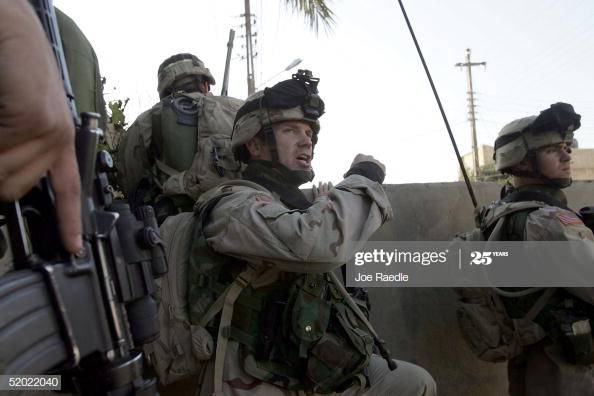US Army in Europe hones rapid deployment skills
The US Department of Defense this year began the previously planned deployment in Europe of an armored brigade combat teams ABCT and combat aviation brigades CAB with appropriate equipment and military personnel. They were deployed on a rotational basis in countries bordering Russia as part of a plan to prevent threats from the Kremlin. The main purpose of these units is to quickly move to target areas on European territory. The task of the command is to organize the process of rotation and the holding of regular exercises, which are an integral part of the program for all incoming troops, and the main goal of such exercises is to increase the speed of deployment of these forces.
Containment of Russia: Army hones skills in working with a large number of equipment and military personnel in Europe
Surprise from the US Army: American helicopters in Poland
Commander of the US forces in Europe, Lieutenant General Ben Hodges has repeatedly said that the role of the army in the European region over the past two years has been to reassure America’s allies who are worried about the Russian invasion of Ukraine and fear the spread of this aggression in the Baltic countries and throughout Of Eastern Europe.
This year, the program has moved into a more active phase – from “reassurance” to direct “containment,” the commander explained in an interview with the publication. This part of the plan includes the direct transfer of military personnel with equipment to the region, where nine months later they will be replaced by other military personnel. This brigade will be distributed among the respective areas of responsibility within the framework of the Atlantic Resolve mission, which, through exercises and other operations, is designed to reassure European allies in the face of an unpredictable RF. One of the tank battalions will go to NATO’s Baltic region, the other to Romania and Bulgaria, Hodges explained in an interview with DN in October. The main part of the group will remain in Poland, where the best landfills and maintenance bases in the region are located.
The American army faced the main difficulty in January, when it was necessary to move large quantities of military equipment arriving at the German port to the target areas using road and rail transport – and the mission participants successfully coped with this task. Within 14 days of arriving in Bremerhaven, tank units were already in Poland on full alert, commander Major General Dwayne Gamble said this week. Next time, this period is planned to be reduced to 10 days.
American Atlantic Decision exercises in Poland
More than 2,000 troops of the 3rd brigade of the 4th division, based in Fort Carson (Colorado), crossed the Atlantic Ocean and arrived in Germany, where the local American command and allies in the North Atlantic Alliance unloaded ships for 36 hours and prepared the equipment for transportation to destinations. DN calls this operation the largest over the past twenty years, the transfer of US units to Europe.
Gamble expects the brigades to be in Europe – as was said, on a rotational basis – for at least five years. It is emphasized that the speed of deployment is crucial in the event that Russia suddenly decides to attack one of the Baltic countries. That is why the American troops during the exercises have to learn how to quickly and freely move around the allied countries from their bases in Europe. The current team managed to meet the four-day deadline, and the next one, which will replace the current one in September, intends to throw into the zone of potential hostilities even more swiftly.
Despite the fact that this time it was possible to complete the transfer from the base point to the venue for the exercises in 4 days, Gamble was in no hurry to rejoice and told reporters that under other circumstances such a process could take up to 30 days. This period may turn out to be too long, while mobile units of the Russian army may be able to do the same in much shorter terms.
With this in mind, the command of American forces in Europe is now working to speed up the deployment of the existing forces many times over. In particular, for this purpose, 50 service technicians were selected from 3.4 thousand personnel of the aviation brigade: in the fall, they will participate in the unloading of ships arriving from the United States, as well as stationary warehouses.
US Army tank firing in Poland at the Atlantic Resolve exercises (January, 2017)
It is noted that the bulk of the equipment that arrived this winter set off on rails. This way of moving a large amount of equipment looks faster compared to transportation on the highway and will become the new standard for transporting equipment.
In September, Hodges plans to visit several European ports, which will be tested for the possibility of accepting military supplies so that they can then be transported to other points in the shortest possible time.
The command is also working to learn how to move the aviation brigade to the places of potential hostilities in just 72 hours – the corresponding maneuver will be practiced already in the coming summer exercises, Gamble explained.
In June, the Saber Strike exercises will be held in the three Baltic republics, where the main focus will be on the development of a joint operations management system, and in July, the Guardian Sword exercises will be held in Romania, Bulgaria and Hungary, and they will work on them appropriate maneuvers of the aviation brigade, as well as testing Army Prepositioned Stocks – a system of military equipment designed for ultra-fast deployment during an emergency.
Answer to Putin: US Army plays muscle in exercises in Poland
Gamble is not yet sure that the aviation brigade is really ready for a 72-hour deployment now. He is sure that this task will be within her power if her main part is based on the Polish military base, but the task will become more complicated if the air brigade is located on the Black and Baltic Seas.
Finally, another area of the American forces’s work in Europe will be the development of logistic operations with the Enhanced Forward Presence, special multinational troops deployed in Poland, Estonia, Latvia and Lithuania according to a separate agreement, each with a battalion country-to protect against potential aggression of the Russian Federation. The operation is attended by 4 thousand troops.
This post is also available in:
 English
English  Русский (Russian)
Русский (Russian)






